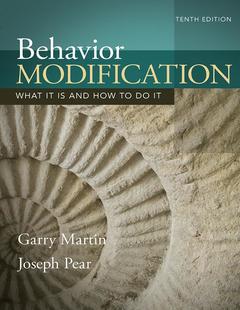Behavior Modification (10th Ed.) What It Is and How To Do It
Auteurs : Martin Garry, Pear Joseph J.

Behavior Modification,10/e assumes no specific prior knowledge about psychology or behavior modification on the part of the reader. The authors begin with basic principles and procedures of behavior modification and then provide readers with how-to-skills such as observing and recording. Next, the authors provide advanced discussion and references to acquaint readers with some of the empirical and theoretical underpinnings of the field. Readers will emerge with a thorough understanding of behavior modification in a wide variety of populations and settings.
Part I : The Behavior Modification Approach
Chapter 1: Introduction
Chapter 2: Areas of Application: An Overview
Part II : Basic Behavioral Principles and Procedures
Chapter 3: Respondent (Classical, Pavlovian) Conditioning of Reflexive Behavior
Chapter 4: Increasing a Behavior with Positive Reinforcement
Chapter 5: Increasing Behavior with Conditioned Reinforcement
Chapter 6: Decreasing a Behavior with Extinction
Chapter 7: Getting a New Behavior to Occur with Shaping
Chapter 8: Developing Behavioral Persistence With Schedules of Reinforcement
Chapter 9: Responding at the Right Time and Place: Stimulus Discrimination and Stimulus Generalization
Chapter 10: Changing the Control of a Behavior with Fading
Chapter 11: Getting a New Sequence of Behaviors to Occur with Behavior Chaining
Chapter 12: Differential Reinforcement Procedures to Decrease Behavior Decreasing Tommy’s Talking Out
Chapter 13: Decreasing Behavior With Punishment
Chapter 14: Establishing Behavior by Escape and Avoidance Conditioning
Chapter 15: Respondent and Operant Conditioning Together
Chapter 16: Transferring Behavior to New Settings and Making It Last: Generality of Behavioral Change
Part III:Capitalizing on Antecedent Control Procedures
Chapter 17: Antecedent Control: Rules and Goals
Chapter 18: Antecedent Control: Modeling, Physical Guidance, and Situational Inducement
Chapter 19: Antecedent Control: Motivation
Chapter 20: Behavioral Assessment: Initial Considerations
Chapter 21: Direct Behavioral Assessment: What to Record and How
Chapter 22: Doing Behavior Modification Research
Part V: Putting It All Together to Develop Effective Behavioral Programs
Chapter 23: Functional Assessment of Problem Behavior
Chapter 24: Planning, Applying, and Evaluating a Behavioral Program
Chapter 25: Token Economies
Chapter 26: Helping an Individual to Develop Self-Control
Part VI: Behavior Therapy for Psychological Disorders
Chapter 27: Approaches to Behavior Therapy: Cognitive Restructuring, Self-Directed
Chapter 28: Psychological Disorders Treated by Behavioral and Cognitive-Behavioral Therapies
Part VII: A Historical Perspective and Ethical Issues
Chapter 29: Giving It All Some Perspective: A Brief History
Chapter 30: Ethical Issues
Garry Martin, a native Manitoban, attended Colorado College on a hockey scholarship, where he received the BA degree. He then attended Arizona State University for the MA and PhD degrees. Garry returned to Manitoba in 1966 and taught in the Department of Psychology at the University of Manitoba until his retirement at the end of 2008. He is currently a Distinguished Professor Emeritus at the U of M, and he continues to supervise graduate students, teach part-time, and write and publish. He has co-authored or co-edited 8 books and over 150 journal articles on various areas in behavioral psychology. His book, Behavior Modification: What It Is and How to Do It, with Dr. Joseph Pear, first published in 1978, is used as a primary text at many universities in 14 countries and various editions have been translated into Spanish, Italian, Portuguese, Chinese, and Korean. His research on behavioral training technologies for improving the quality of life of people with developmental disabilities and children with autism has been supported continuously by the Medical Research Council of Canada, and now the Canadian Institutes of Health Research for the past 32 years. He has been an invited speaker at numerous national and international conferences around the world. He has supervised 38 Masters theses, and 32 PhD theses at the University of Manitoba, and has received numerous honors and awards, including induction into the Royal Society of Canada. At the 2010 Annual Convention of the Canadian Psychological Association, Garry received the CPA Education and Training Award, the most prestigious education and training award the discipline confers in Canada.
Dr. Joseph J. Pear, Professor of Psychology at the University of Manitoba, received the B.S. degree from the University of Maryland and the M.A. and Ph.D. degrees from The Ohio State University. A fellow of Division 6 (Behavioral Neuroscience and Comparative Psychology) and Division 25
Date de parution : 06-2019
21x28 cm
Disponible chez l'éditeur (délai d'approvisionnement : 14 jours).
Prix indicatif 293,12 €
Ajouter au panierDate de parution : 08-2019
21x28 cm
Disponible chez l'éditeur (délai d'approvisionnement : 12 jours).
Prix indicatif 76,50 €
Ajouter au panierThème de Behavior Modification :
Mots-clés :
Behavior Analysts; Conditioned Reinforcer; Applied Behavior Analysts; Behavior Modification Program; Behavior Modifier; Behavior Therapists; Backup Reinforcers; Alternative Desirable Behavior; Behavior Modification; Target Behaviors; Operant Extinction; Conditioned Punisher; Operant Conditioning; Developmental Disabilities; Token Economies; Applied Behavior Analysis; Stimulus Generalization; Self-injurious Behavior; Conditioned Reinforcers; Unconditioned Reinforcer; Aversive Stimuli; Term Behavior Modification; Physical Guidance; Conditional Reflexes; Intermittent Reinforcement



